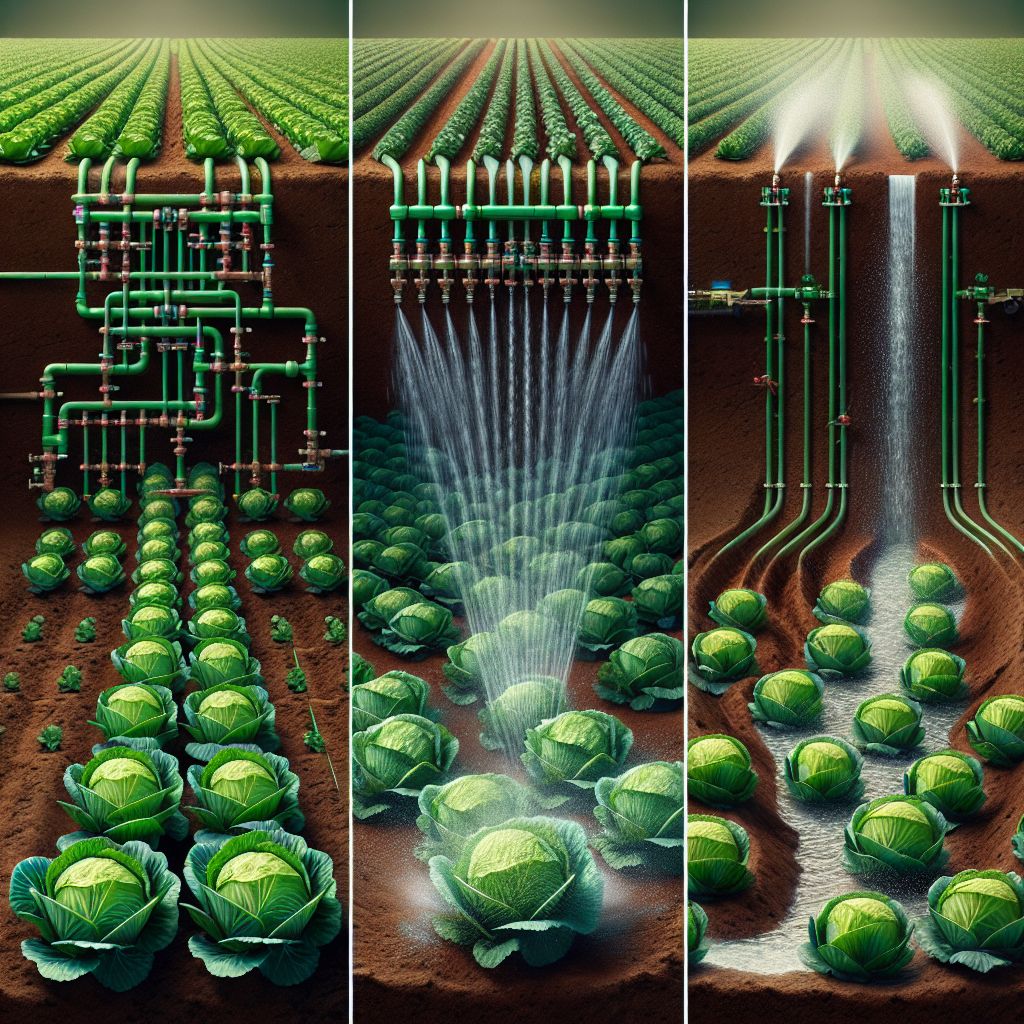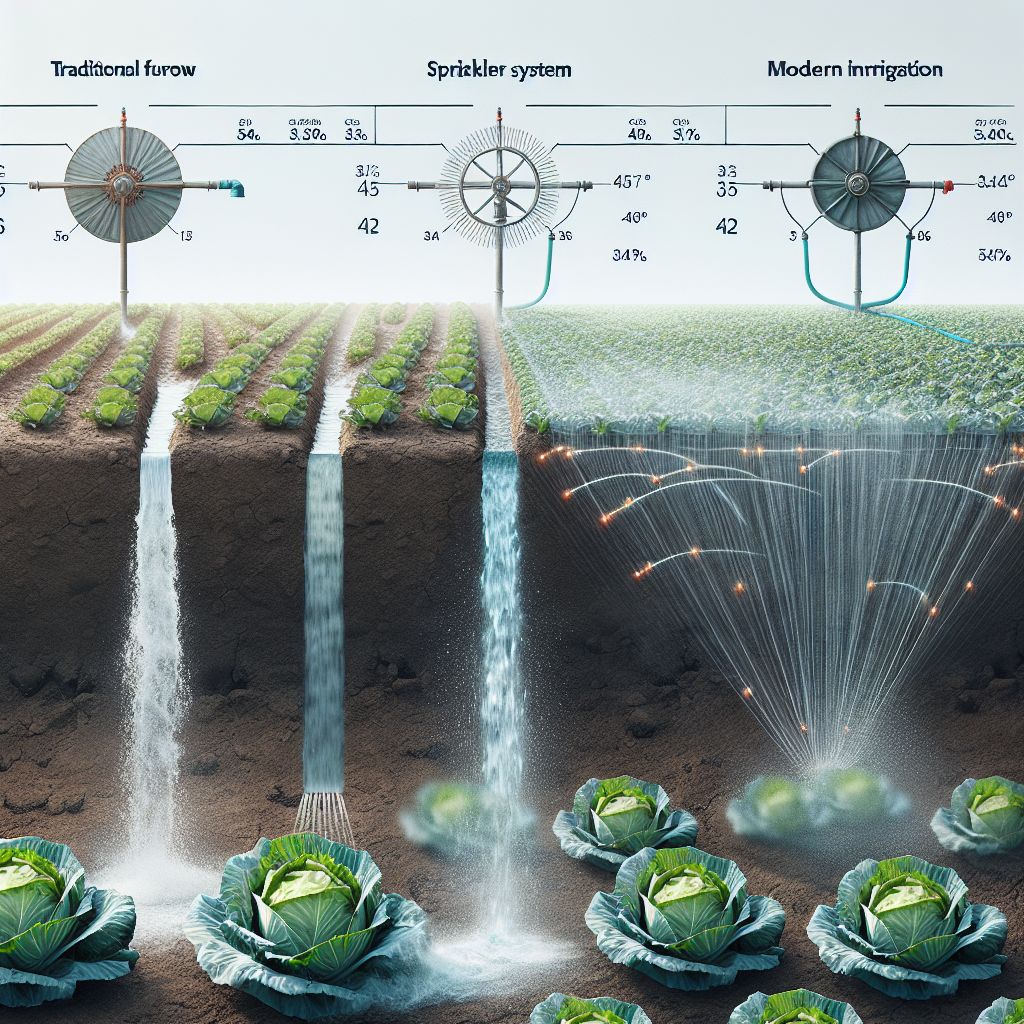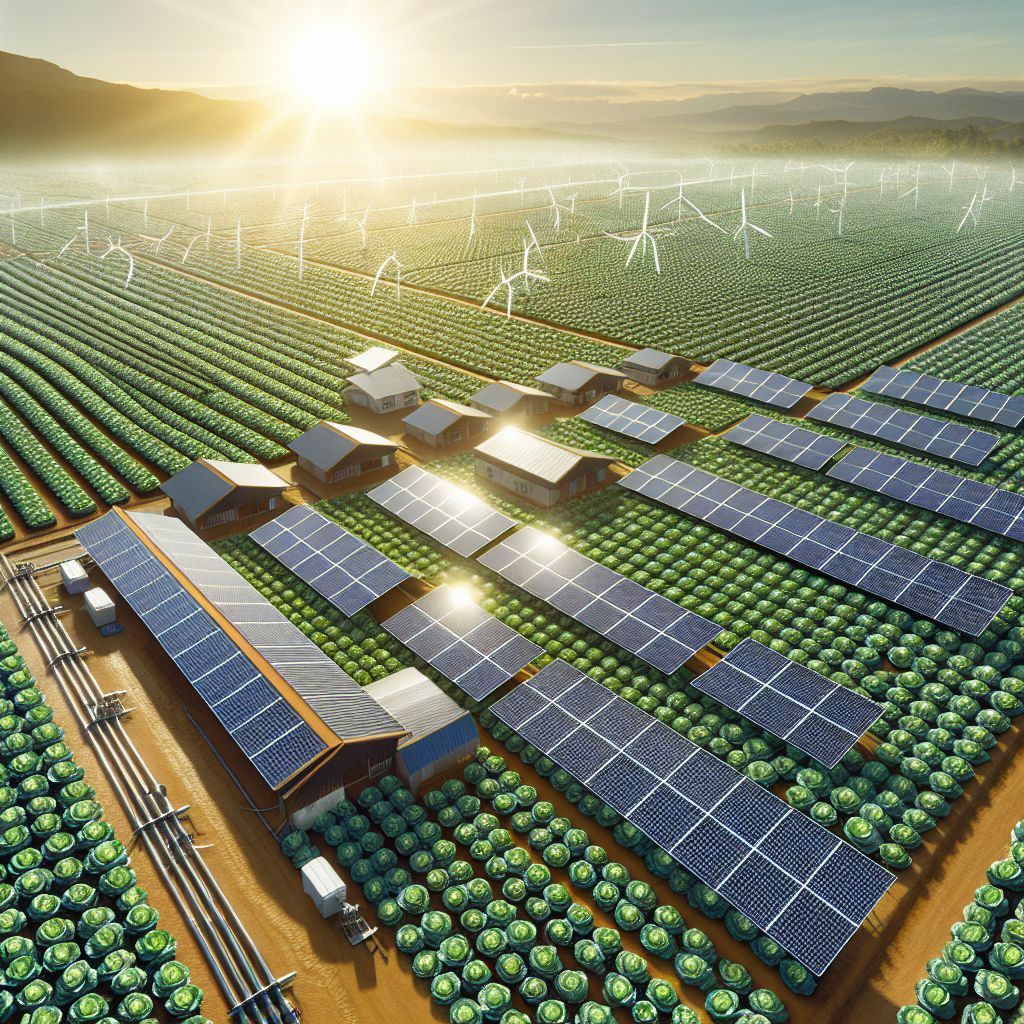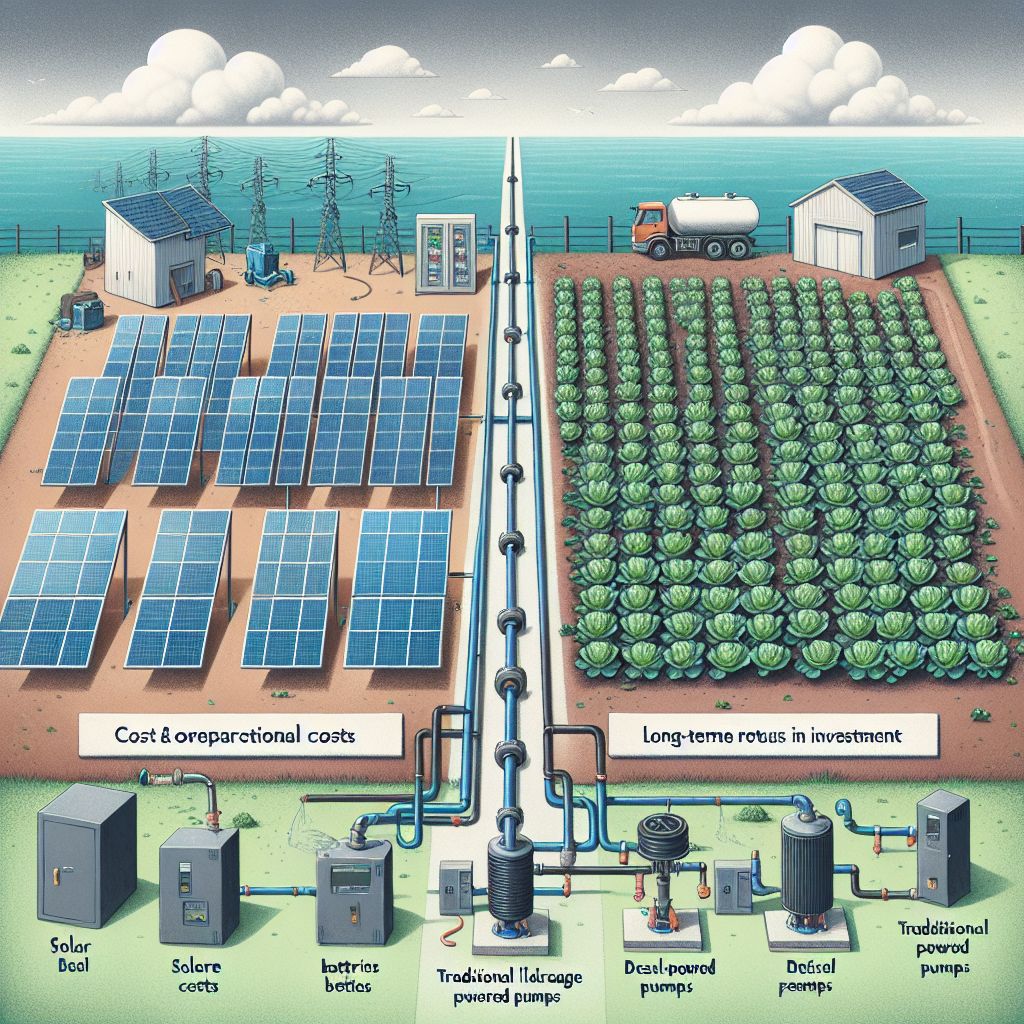
Key Takeaways
Solar irrigation systems can significantly increase the efficiency of watering cabbage crops.
Drip irrigation is the most precise method for watering cabbages, leading to healthier plants and better yields.
Solar panels reduce the environmental impact of irrigation by using renewable energy.
Initial investments in solar irrigation can be offset by long-term savings and potential government incentives.
Choosing the right type of solar panel and system design is crucial for optimizing irrigation and energy use.
The Benefits of Pairing Solar Panels with an Irrigation System
Imagine a cabbage farm where the plants are lush, the soil is moist, and the energy bills are low. This is not a dream but a reality made possible by solar irrigation systems. By harnessing the power of the sun, these systems pump water to thirsty crops without relying on the grid, cutting costs and conserving energy.
Most importantly, solar irrigation systems are not just good for your wallet; they’re good for the planet. By reducing the reliance on fossil fuels, these systems contribute to a greener, more sustainable form of agriculture. And in the world of cabbage farming, where water and energy use can be significant, the impact is even more profound.
For instance, a farmer in California switched to solar-powered irrigation and saw a 70% reduction in energy costs, with an added benefit of increased crop yield due to more consistent and efficient watering.
Benefits of Integrating Solar Power into Farming Practices for Growing Cabbage
When it comes to growing cabbage, water is a critical resource. Cabbage plants are made up of over 90% water, so consistent and adequate irrigation is key to producing a successful crop. Integrating solar power into farming practices can lead to more predictable watering schedules, better moisture control, and ultimately, more robust cabbage heads.
Because cabbages have shallow root systems, they require frequent, light watering. This can be energy-intensive with conventional systems, but solar-powered solutions provide a sustainable alternative. The energy saved translates into lower operational costs and a smaller carbon footprint.
How Solar Panels Enhance Irrigation Efficiency
Using solar panels for irrigation translates into enhanced efficiency in several ways. First, solar panels can power pumps directly during daylight hours, when plants are most in need of water. This synchronization ensures that water is used when it can be most beneficial to the plants.
Besides that, the use of solar panels can lead to smarter water usage. Advanced solar irrigation systems can include sensors that monitor soil moisture and weather conditions, adjusting the watering schedule accordingly to prevent over or under-watering.
Environmental Impact Reduction with Solar-Powered Irrigation
The environmental benefits of solar-powered irrigation systems are clear. By utilizing renewable energy, these systems reduce the greenhouse gas emissions associated with traditional fossil fuel-powered pumps. Moreover, precision watering techniques minimize runoff and water waste, preserving this precious resource.
It’s important to note that the adoption of solar irrigation also aligns with global efforts to combat climate change. As more farms transition to renewable energy, the agriculture sector can significantly contribute to reducing overall emissions.

Different Irrigation Systems Used to Grow Cabbage
Choosing the right irrigation system is crucial for growing cabbage. The method you select will depend on various factors, including the size of your farm, the topography of the land, and the availability of water.
Drip Irrigation: Precision Watering for Healthier Cabbages
Drip irrigation stands out as the most efficient method for watering cabbages. It delivers water directly to the base of each plant, minimizing evaporation and ensuring that every drop goes to good use. This targeted approach prevents the spread of diseases that can occur when water sits on cabbage leaves.
With a drip system, water is slowly released to the plants’ roots through a network of valves, pipes, tubing, and emitters. This method can save up to 60% more water than conventional irrigation methods and can result in better crop yields due to the controlled and precise application of water.
Sprinkler Systems: Broad Coverage for Larger Cabbage Fields
Sprinkler systems are another option for cabbage irrigation, especially for larger fields. These systems mimic rainfall by spraying water over the crops. While they offer broad coverage, they can be less efficient than drip systems, as some water may evaporate before reaching the plants or be carried away by wind.
Furrow Irrigation: A Traditional Approach and Its Limitations
Furrow irrigation is one of the oldest methods, where trenches are dug between rows of crops, and water flows down these furrows to water the plants. While it’s a low-cost option, it’s also less efficient, with a significant amount of water lost to evaporation and runoff.
Moreover, furrow irrigation can lead to uneven water distribution, with plants at the start of the furrow receiving more water than those at the end. This can result in inconsistent crop quality and lower yields.

Comparing the Cost and Efficiency of Traditional Furrow and Sprinkler Systems to Modern Drip Irrigation Systems for Growing Cabbage
Analyzing the Costs of Traditional Irrigation Methods
Traditional furrow and sprinkler systems have been the backbone of agricultural irrigation for decades. They are relatively inexpensive to install and simple to operate. However, the true cost of these systems is not just in the initial setup but in the ongoing expenses. They often require a significant amount of water, which can be costly, especially in areas where water is scarce or expensive. For those considering a more sustainable approach, efficient solar irrigation systems may offer a viable alternative.
In addition, these methods can be labor-intensive, as they may require frequent adjustments to ensure even water distribution. This can lead to higher labor costs over time. Furthermore, the less efficient use of water can also contribute to increased fertilizer runoff, which not only affects the environment but can also lead to additional costs for water treatment.
Modern Irrigation Systems: A Cost-Effective Upgrade
Switching to a modern drip irrigation system can seem like a significant upfront investment, but it’s one that pays off in the long run. Drip systems deliver water directly to the root zone of the plants, reducing waste and maximizing efficiency. They can be automated, which lowers labor costs and ensures that plants receive the exact amount of water they need, when they need it.
These systems are also adaptable to various terrains and can be used with different water sources, including recycled water, which further enhances their efficiency. Additionally, because they minimize water contact with the leaves, stems, and fruit of the plants, they reduce the risk of disease, which can save on costs related to crop losses and chemical treatments.
Long-Term Savings with Innovative Watering Solutions
The long-term savings associated with modern drip irrigation systems are significant. By using water more efficiently, farmers can reduce their utility bills. Moreover, the precision watering of drip systems can lead to increased yields, providing more product to sell without a corresponding increase in water usage.
Reduced water bills due to efficient usage
Lower labor costs through automation
Increased crop yields from precise watering
Less water runoff and reduced need for water treatment
Decreased disease risk, lowering the need for chemical treatments
Additionally, the longevity of drip irrigation systems means that, once the initial investment is recouped, the ongoing expenses are much lower than those of traditional systems. Farmers can expect a reliable system that continues to provide cost savings year after year.

Choosing the Right Solar Panels for Your Cabbage Farm’s Irrigation System
When it comes to integrating solar panels with your cabbage farm’s irrigation system, selecting the right type of panel is crucial. The choice will depend on several factors, including the geographic location of your farm, the amount of sunlight your area receives, and the energy requirements of your irrigation system.
It’s important to work with a reputable supplier who can provide high-quality panels and offer guidance on the best system for your needs. A good supplier will consider the specifics of your farm and recommend a system that maximizes energy capture and efficiency.
Another consideration is the space available for installing solar panels. Some farms may have ample unused land, while others may need to get creative with panel placement. Roof-mounted systems or solar trackers that follow the sun’s path can be excellent options for maximizing space and efficiency.
Geographic location and sunlight availability
Energy requirements of the irrigation system
Quality and reputation of the solar panel supplier
Available space for solar panel installation
Finally, you’ll want to consider the durability of the solar panels. Agricultural environments can be harsh, and the panels you choose need to withstand the elements to ensure a good return on investment.
Comparing Solar Panel Types for Irrigation Systems
There are several types of solar panels to consider for your irrigation system. Monocrystalline panels are highly efficient and perform well in low-light conditions, making them a good choice for areas with less intense sunlight. Polycrystalline panels are less expensive but also less efficient, which means you may need more of them to meet your energy needs.
Right below is a table looking at all the different solar panel options:
|
Solar Panel Type |
Efficiency Range |
Advantages |
Disadvantages |
|---|---|---|---|
|
Monocrystalline |
17-22% |
Highest efficiency, space-saving, long lifespan. 2 | |
|
Polycrystalline |
15-17% |
Lower efficiency, requires more space. 2 | |
|
Thin-Film |
10-13% |
Lightweight, flexible, good temperature coefficient. 2 |
Lowest efficiency, requires large area. 2 |
|
Portable Solar Panel Systems |
Varies based on panel type |
Designed for irrigation needs, easy to move and relocate. 1, 3 | |
|
Hybrid Solar Panels |
Varies based on components |
Can combine solar with other energy sources like wind, increased reliability. 4 |
More complex system, higher cost. 4 |
Monocrystalline panels provide the highest efficiency in a compact area but at a higher upfront cost (2, 3). Polycrystalline panels offer a balance of efficiency and cost (2, 3). Thin-film panels have lower efficiency but perform better in high temperatures (2). Portable solar panel irrigation systems allow flexibility in placement and relocation as needed (1). Hybrid systems increase reliability by combining solar with other renewable sources but add complexity (4). The optimal choice depends on factors like available space, budget, local climate conditions, and specific irrigation requirements for the cabbage crop.
Installation Tips for Solar Panels in Cabbage Production
Proper installation is key to getting the most out of your solar panels. Ensuring that panels are installed at the correct angle and orientation maximizes the amount of sunlight they capture. It’s also essential to keep them clean and free of debris to maintain efficiency.
Additionally, the wiring and components used in the installation should be of high quality to prevent energy loss. Using a professional installer who understands the specifics of solar irrigation systems can make a big difference in the performance and longevity of your setup.
Optimizing Solar Energy Capture for Water Pumps
Install panels at the correct angle and orientation for your location.
Maintain clean panel surfaces to ensure maximum sunlight capture.
Use high-quality wiring and components to minimize energy loss.
Consider using a tracking system to follow the sun’s path.
Employ a professional installer with experience in solar irrigation systems.
Remember, the goal is to ensure that your solar panels provide enough energy to run your irrigation pumps without relying on the grid. This not only saves money but also makes your farming operation more sustainable and less vulnerable to power outages and energy price fluctuations.

Comparing the Cost and Efficiency of Solar Irrigation Systems and Traditional Irrigation Systems
With the rising cost of energy, farmers are increasingly looking for ways to reduce their operating costs. Solar irrigation systems offer a potential solution, as they can significantly reduce or eliminate the need for grid electricity. But how do solar irrigation systems compare to traditional irrigation systems in terms of cost and efficiency?
Breaking Down the Initial Investment of Solar Systems
While the benefits of solar irrigation systems are numerous, understanding the initial investment is crucial for making an informed decision. The cost of solar panels has decreased significantly over the years, but the total expense will depend on the size of your irrigation system and the energy requirements of your farm. On average, a small-scale solar panel setup can range from $5,000 to $10,000, while larger systems may cost upwards of $20,000 or more.
However, this investment goes beyond just the panels. You’ll also need to account for the cost of batteries, inverters, wiring, and installation. It’s a package deal, and while it might seem steep at first glance, the potential savings and environmental benefits can quickly offset the upfront costs.
Operational Cost Comparison between Regular and Solar Systems
When comparing operational costs, solar systems shine. Traditional electric or diesel-powered pumps can incur monthly costs from $100 to $500, depending on the size of the operation and local energy prices. In contrast, once a solar irrigation system is installed, the energy it uses is free – as long as the sun is shining, your plants are getting watered without racking up a power bill.
Furthermore, maintenance costs for solar systems are relatively low. Solar panels typically come with warranties of 20 to 25 years, and their lifespan can extend well beyond that. In contrast, traditional pumps and equipment may require more frequent repairs or replacements, adding to their long-term costs.
The Long-Term ROI of Solar-Powered Irrigation for Cabbage Farming
The return on investment (ROI) for solar-powered irrigation in cabbage farming can be impressive. By eliminating ongoing fuel or electricity costs and minimizing maintenance expenses, farmers can recoup their initial investment within 5 to 10 years. After that, it’s essentially free to run, which can significantly increase profit margins.
Additionally, using solar irrigation can increase crop yields by providing consistent and precise watering, which leads to healthier plants and more abundant harvests. This can translate into higher income from the sale of your cabbages, further improving the ROI of the solar irrigation system.
This table compare the pros and cons of solar irrigation systems and traditional irrigation systems:
|
Aspect |
Conventional Irrigation System |
Solar-Powered Irrigation System |
|---|---|---|
|
Pros |
No ongoing energy costs, uses free solar power. 5 | |
|
Simple installation and maintenance. 1 |
Environmentally friendly, reduces carbon footprint. 3 | |
|
Reliable water supply even during power outages. 5 | ||
|
Long lifespan of solar panels (25-30 years). 5 | ||
|
Cons | ||
|
Susceptible to power outages. 5 |
Requires some technical knowledge for installation/maintenance. 3, 4 | |
|
Environmental impact from energy use. 3 |
Risk of over-abstraction of groundwater if not managed properly. 3, 4 | |
|
Potential for water waste/inefficiency. 1 |
Conclusion:
Adopting solar irrigation systems for growing cabbage is a smart move for farmers who want to reduce costs, increase efficiency, and contribute to a more sustainable agricultural practice. With the advancement in solar technology and the decrease in costs, there has never been a better time to invest in a solar-powered watering solution. While the initial investment may be substantial, the long-term benefits and cost savings make solar irrigation an attractive option for modern farming.
Frequently Asked Questions (FAQ)
Below are answers to some common questions about solar irrigation systems for cabbage farming:
What Are the Primary Advantages of Solar Irrigation Systems for Cabbage Farming?
The primary advantages of solar irrigation systems for cabbage farming include:
Significant reduction in water and energy costs
Increased watering efficiency and precision
Lower environmental impact due to renewable energy use
Improved crop yield and quality
Long-term savings and potential for government incentives
Can Solar Irrigation Systems Be Used in Areas with Limited Sunlight?
Yes, solar irrigation systems can be used in areas with limited sunlight. While they are most efficient in sunny conditions, modern solar panels are capable of generating energy even on cloudy days. Additionally, battery storage systems can store excess energy generated on sunny days for use during less sunny periods.
How Do Solar Irrigation Systems Contribute to Sustainable Agriculture?
Solar irrigation systems contribute to sustainable agriculture by:
Using clean, renewable energy to power irrigation pumps
Reducing greenhouse gas emissions associated with traditional energy sources
Conserving water through precise and controlled irrigation
Decreasing the reliance on non-renewable resources
What Is the Expected Lifecycle of a Solar-Powered Irrigation System?
The expected lifecycle of a solar-powered irrigation system can exceed 25 years. Solar panels are designed to withstand harsh weather conditions and have long warranties. With proper maintenance, the other components of the system, such as pumps and batteries, can also have extended lifespans.
Do Government Incentives Exist for Solar Irrigation Technology Adoption?
Various governments globally provide incentives for the adoption of renewable energy technologies, such as solar irrigation systems. These incentives may be in the form of grants, low-interest loans, tax credits, or rebates, all of which can help reduce the initial investment costs.
Farmers should take the time to investigate the particular incentives in their area. These can greatly lower the financial hurdles to adopting solar irrigation. Agricultural development or renewable energy groups can offer advice and help in obtaining these incentives.
Solar irrigation systems are becoming increasingly popular in agriculture, offering a sustainable and cost-effective solution to traditional watering methods. Among the various crops that can benefit from these systems, cabbage is a prime candidate. Cabbage requires consistent moisture levels for optimal growth, and the precision of solar irrigation systems can provide just that, reducing water waste and ensuring that water use is optimized to meet the crop’s specific needs.







Leave a Reply